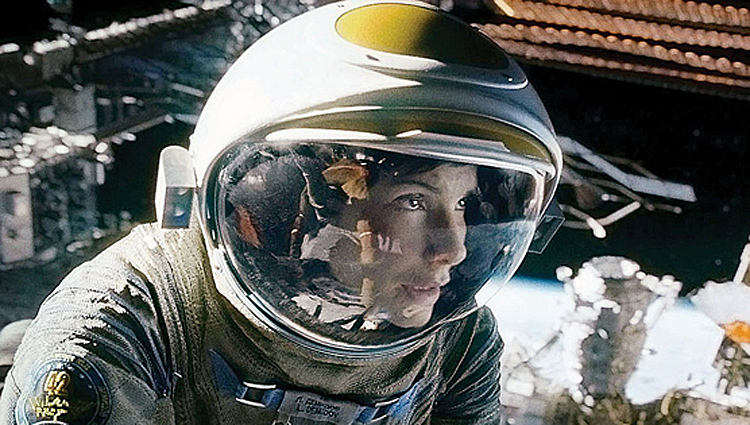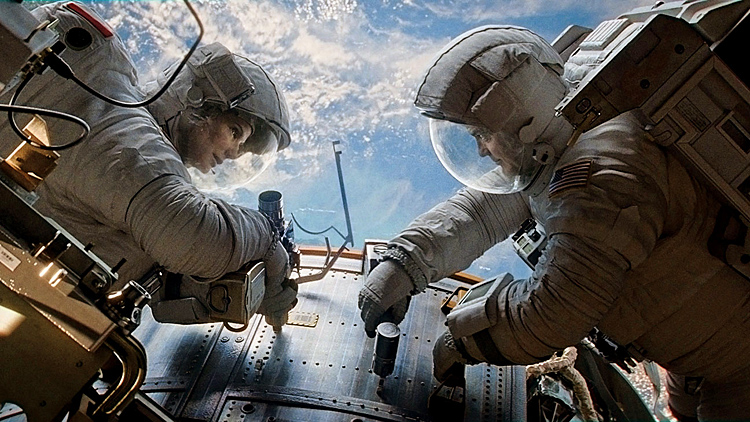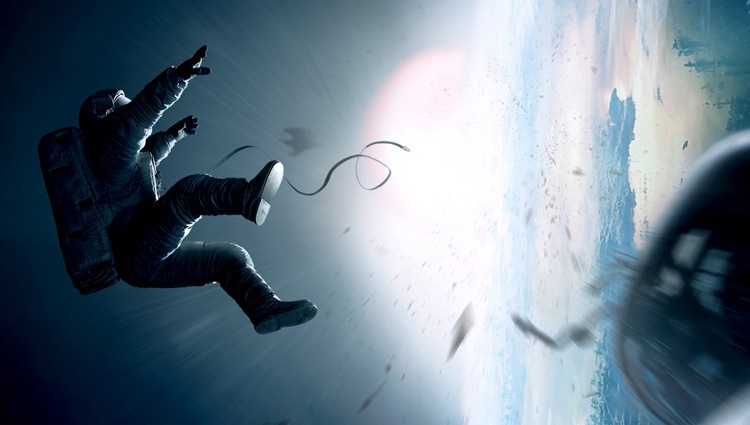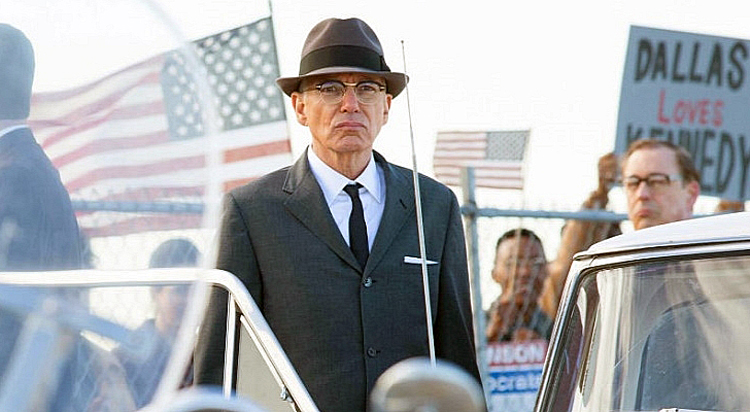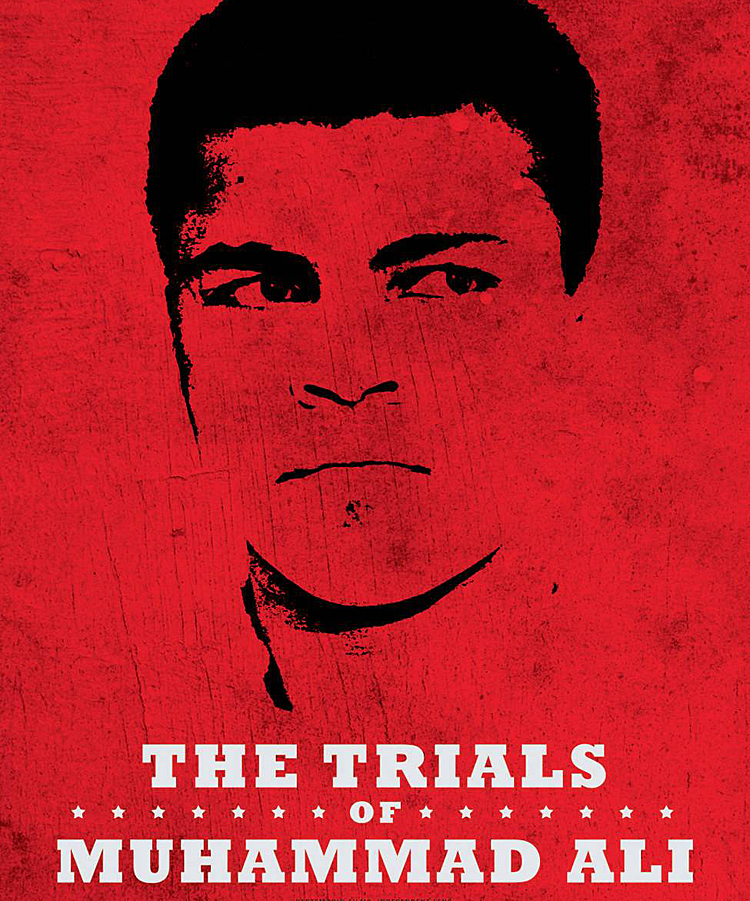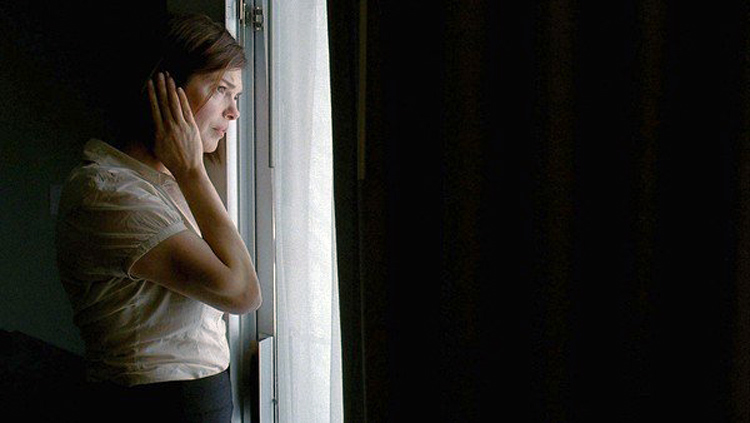
By Robin E. Simmons
GRAVITY
Don’t miss this incredible film now showing in 3D on the big Desert Imax screen with its awesome 15,000 watt surround sound system. Here finally is a movie that does justice to 3D. (An exploitive format I usually hate.) This cutting edge thrill ride of a movie is terrifying, majestic and transcendent. It’s the next leap in the craft of filmmaking.
Written by director Alfonso Cuarón (with his son Jonás) and exquisitely photographed by Emmanuel Lubezki, most of the action takes place 400 miles above the earth. Visual effects supervisor Tim Webber helped design proprietary technology and software that makes it all hyper real. Warner Bros, to their great credit, patiently funded the research and development and waited until everything was in place and working seamlessly. And if there were any lingering doubts, you know you are in good hands with the sweeping, jaw-dropping opening sequence that unfolds –without a cut! — in about 15 minutes of weightless wonder and terror. And mention should be made here of Stephen Price’s terrific score that envelops us and further evokes the wondrous expanse in which we literally float.
The story line is simple: Two astronauts encounter a problem and are left adrift in space. Any further description of the movie’s specifics will greatly diminish the extreme pleasure of the actual viewing experience. Rest assured that a trip to the cinema will be richly rewarded. The 3D effects, especially in the Imax format, are bright and crystal clear. For me, the feeling of weightlessness and the great depth that stretches in all directions into the infinitude of space is here made exhilarating and, ironically, virtually palpable, perhaps for the first time on the big screen.
At its best, GRAVITY is a dreamlike (sometimes nightmarish) experience of wonder, fear and awe. It’s everything a movie is supposed to be but rarely is. We have finally reached a point where anything imaginable can be photo realistically realized on the big screen.
GRAVITY can be enjoyed as an action filled suspense thriller and nothing more. But I think there’s a deeper level of awareness as we experience first-hand the terror of being alone and adrift in the cosmos. After all, isn’t that our true existential condition?
Sandra Bullock perfectly captures her character’s dilemma and emotion. She is vulnerable, heroic and fully human. Often her face is barely visible inside her astronaut headgear, but there is no doubt about how she feels. This is her best performance by far and I would not be surprised to see her nominated for a Best Actor Oscar©. George Clooney is just right as the comforting partner when a horrific accident kills the rest of their team and they are left utterly alone.
As Clooney’s character says: “What’s the point of life? Relax. Sit back and enjoy the ride.” Let go of fear and live your life. The bar has been raised in the art and craft of filmmaking. Now playing in 2D and 3D. But see it in 3D.
PARKLAND
Adapted from Vincent Bugliosi’s “Four Days in November,” PARKLAND attempts to recreate the chaos and impact on the lives of those who were peripheral to the murder of President John Fitzgerald Kennedy in Dallas on November 22, 1963. Parkland Memorial Hospital is where Kennedy was taken in the minutes immediately after he was shot. There’s no reason this movie should exist.
If you want to know what it was like to be at Parkland that fateful day and the impact of that unexpected, horrible event on just one life, see “PARADIGM SHIFT AT PARKLAND” in this issue of CVW.
PARKLAND, with its multitude of ever-shifting perspectives and widely uneven, it’s not really a very good movie for a lot of reasons, the biggest of which is that it follows the blueprint of the Warren Commission’s conclusion that Lee Harvey Oswald was the lone nut shooter. Bugliosi’s book endorses that notion (even though many critics have shredded it’s credibility in this matter). There are no new revelations about that day in this movie that seems to have a political objective. However, one performance stands out, and that is Billy Bob Thornton’s remarkable disappearance into the conflicted skin of troubled FBI Agent Forrest Sorrels. Now playing.
THE TRIALS OF MUHAMMAD ALI
He is an icon, a champion and an American hero who was vilified for his race, his religion and his political stance against the war in Vietnam. He won a gold medal for boxing in the Olympics, but when he took a stand for what he believed, he was stripped of his professional boxing status, fined thousands of dollars and faced a five year prison sentence and a felony conviction. Cassius Marcellus Clay disappeared when Muhammad Ali emerged as an articulate spokesperson for another kind of Islam than we discuss today, one that forbids doing harm to strangers and women. THE TRIALS OF MUHAMMAD ALI is just that: a film that explores how the most celebrated sports champions of the 20th century risked his fame and fortune to follow his faith and conscience and the legal firestorm that ensued. Director Bill Siegel has put together a fascinating and provocative assemblage of vintage clips and talking heads that remind us there’s not only a price to pay for taking a moral stand and not wavering, but sometimes a reward. Muhammad Ali received the Presidential Medal of Freedom on November 9, 2005 at a ceremony in the White House. This is not a movie about the boxer, but the man. Now playing at Camelot Theaters in Palm Springs.
MORNING
Leland Orser’s film about a couple coping with the loss of their young son might seem like a grim notion for an evening’s “entertainment.” But this beautiful gem of a film is about hope and healing. It is a therapeutic detox for the kind of unfathomable pain pain the kills the soul. The words are minimal. The images and action dominate. There’s much silence. For some reason, I was reminded of the short stories of Flannery O’Connor. Orser plays the distraught husband and Jeanne Tripplhorn, his real life wife, plays the numb wife. Intimate and gut wrenching, Orser and Tripplehorn take parallel paths to assuage their guilt and grief. Pain and suffering is the one thing we all have in common. That, and the desire for love. I liked this exploration of the resilience of the human spirit to be brave enough to let go and love again.
NOTE: Filmmaker Orser will participate in a Q&A following the Friday, October 11, 6:30 performance of MORNING at Cinemas Palme d’Or.
Comments? RobinESimmons@aol.com



































